 ] [
] [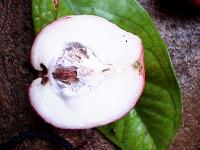 ] [
] [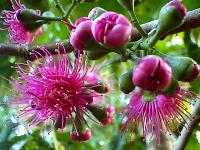 ]
][ ] [
] [ ] [
] [ ]
]
[ ]
]
Syzygium malaccense (formerly Eugenia malaccensis). Identification based on a drawing done by J.J. Ochse in 1931, information from Maurice Kong, and Chris Rollins. Drawings and information provided by Kirsten Llamas, Botanist. Also called "Apel en Pohnpei" on Pohnpei. On Kosrae this fruit is referred to as a Kosraen apple (apul). One source notes that the flower can also be white.
[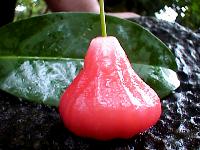 ] [
] [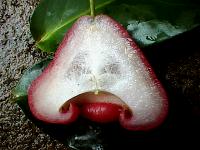 ] [
] [ ][
][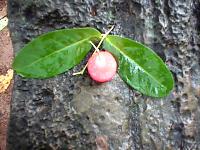 ][
][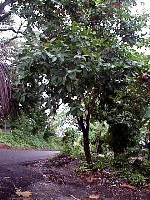 ]
]
Syzygium jambos. Identification based on a drawing done by J.J. Ochse in 1931, information from Maurice Kong, and Chris Rollins. Drawings and information provided by Kirsten Llamas, Botanist. Referred to as "foreign apple, large." On Kosrae this apple is referred to as a Pohnpei apple.
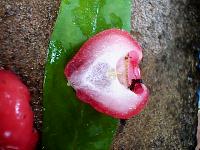
Referred to as "appel en katik," (Elias Thomas) or "sour apple." Also called "Apel en wai" on Pohnpei but is recognized as being different. Referred to as "foreign apple, small." This fruit is consistenty smaller and is sour. A favorite with soy sauce and salt.
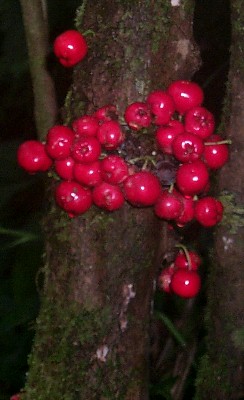
Identification based on Bill Raynor's plants of Pohnpei spreadsheet. On 16 October 1999 Dr. Don Buden and Brian Lynch photographed the above "wild" apple (kirek en wel) on a hike into the mountains of Pohnpei. This apple is found only in the mountains. The apple is bourne on the trunk of the tree and is the "fourth" type of "wax apple" that exists on Pohnpei.
When placed in the same shot, the three apples appear as seen below:
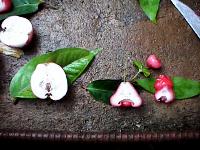
Left to right: Apel, apel en wai (laud), apel en wai (tikitik). Each is sitting on its own leaf.
Based on the drawings of J.J. Ochse the following table can be prepared for the image above, with the apples considered from left to right in the image, from top to bottom in table:
| Fruit | Flower | Possible English name | Probable Pohnpeian name | Kosraen name (Shrue Kilafwasru) | Possible identification |
|---|---|---|---|---|---|
| Dull Red with white streaks, ovoid. 7 to 10 cm tall. | bright red, crimsony purple. | Malay apple | apel en Pohnpei or just plain apel | apel en Kosrae | S. malaccense (Eugenia malaccensis) |
| Shiny, red, pear shaped, up to 5 cm tall. | creamy white | Java apple | apel en wai laud |
apel en Pohnpei | S. jambos |
| Shiny, red, pear shaped, 2 to 3 cm tall. | apel en wai (katik) tikitik | S. jambos | |||
| bright red outside, white on inside | [Mountain wax apple] | kirek en wel | S. stelecantha (Eugenia stelecantha) |
The tentative S. samarangense identification and English names are based descriptions in Hortus III provided by K. Llamas. Hortus lists the present name of E. javanica as S. samarangense, but the description suggests that the smaller apple is S. samarangense. Note that the word "tikitik" means "small" and "laud" means "large."
Bill Raynor, has the following members of Eugenia listed as being present on Pohnpei:
| Genus | Species | Source | Alternate | Family | Pohnpeian name |
|---|---|---|---|---|---|
| Eugenia | aquea | Burm. f. | Syzygium auqueum (Burm. f.) Alst. | Myrtaceae | apel |
| Eugenia | carolinensis | Koidz. | Syzygium carolinensis (Koidz.) Hosokawa | Myrtaceae | kenpap |
| Eugenia | caryophyllus | (Spr.) Bull. & Harr. | Myrtaceae | ||
| Eugenia | jambos | L. | Myrtaceae | iou en wai | |
| Eugenia | javanica | Lam. | Syzgium samarangense (Bl.) Merr. & Perr. | Myrtaceae | apel en wai |
| Eugenia | malaccensis | L. | Myrtaceae | apel | |
| Eugenia | stelecantha | (Diels.) Kanehira | Myrtaceae | kirek en wel | |
| Eugenia | uniflora | L. | Myrtaceae | ||
Arthur Whistler, in Tongan Herbal Medicine, appears to concur with the identifications at the top of this page. "Syzygium malaccense... the four red petals fall early to expose the numerous, showy red stamens 1-2 cm long. The flesh, glossy red to white, obovoid fruit is mostly 3-7 cm long and contains a single large seed." Tongan Herbal Medicine, W. Arthur Whistler.
The University of Hawaii at http://www.botany.hawaii.edu/faculty/carr/myrt.htm adds a high quality picture of a white flower labelled Syzygium jambos http://www.botany.hawaii.edu/faculty/carr/images/syz_jam.jpg, calling it a "rose apple" and the information that "This is a large tree with edible fruit. Note the very dominant nature of the androecium in the open flower." Immature apples can be seen developing behind the white flower. This concurs with the identifications at the top of this page.
The site http://www.cdfa.ca.gov/plant/agidaid/page54.htm provides an image of a fruit with the bell shape of the "Apel en wai" apple and calls this fruit Syzygium malaccensis. This same site provides the following description: "Bell-shaped, about 2 inches long, skin yellow-red to red when ripe, white flesh." with the following common names: "Mountain apple, Malay apple, Malay rose apple, Jambu merah, Pomerac jambos." [This now appears to actually be S. jambos]
Another site, http://www.batcon.org/ffecon4.html , distinguishes between Syzygium malaccense and Syzygium samarangense by noting that S. malaccense "Fruit eaten and is juicy but tasteless." while S. samarangense "Fruit eaten and is better than other species in genus for this purpose." This site also describes Syzygium jambos with the phrase, "Fruit eaten fresh ("jambu" or Rose apple); popular local fruit." No image is provided.
The site
http://www.carambolafly.com/annual96.html , only adds the following information:
Syzygium cuminii 'djamoen'
Syzygium malaccensis malay apple
Syzygium samarangense java apple
The site http://www.xc.org/echo/onplanta.htm also adds only naming information, calling Syzygium cumini the Jambolan or Java Plum and Syzygium samarangense the Wax Jambu. Both of the local apples have a very waxy appearance.
The following description of S. cumini was provided by K. Llamas from a conversation with Maurice Kong: "Syzygium cumini, Jambolan plum, is naturalized in south Florida and has a distinctly broader leaf and a purple, oval fruit about an inch long. The naturalized one here is sour but Maurice says there are sweet forms." I have no acquaintance with such a fruit on Pohnpei.
UH also has images of Syzygium cumini noting that this is also known as the "Java plum, jambolan plum" and is a "tree from E. Indies and Burma, with white flowers and purple to black, globose, edible fruit." Neither of these appear to match, as far as I can tell from the images, our local apple types.
Various other sites with images:
http://zoneten.com/nurseryplants.htm
http://www.tropicalfruittrees.com/w.htm
l
http://www.proscitech.com.au/trop/link.htm
The later site provides the following name list:
Syzygium aqaeum - bell fruit
S. cumini - jambolan
S. jambos - roseapple
S. malaccense - Malay apple
S. pycnanthum - wild rose apple
S. samarangense - wax jambu
A picture of S. aqaeum is provided, the image is of small, red, bell shaped fruits that appear slightly more flattened top to bottom than the "Apel en wai."
From Hortus III, comments added by K. Llamas, emphasis by web page author:
S. malaccense (E. malaccensis, Jambosa malaccensis) Malay apple, Rose apple, Large-fruited r.a., Pomerac, Jambos. Tree 15-40', leaves ovate/oblong, 6-12" long; flowers from old wood (!), [brilliant!] purplish-red in few flowered cymes, fruit PEAR-shaped, to 2" long [does not give color! ], seed large, brown, Malay Pen., fruit eaten raw or cooked. One of the most beautiful tropical trees.
S. jambos (syn E. jambos; E. malaccensis Lour. NOT L!! [this may be part of the problem if you are using old texts], Jambosa jambosa) Rose apple, Malabar plum. tree to 40', leaves lanceolate, to 8", flws greenish-white [I would call them cream], 2-3" across in few-flowered [the flowers open a few at a time but there are at least 10 buds in a cluster] clusters, stamens long and showy, fruit cream-yellow, OVOID, to 1.5" long, fragrant. fruit dry, crisp, rather insipid raw but prized for preserves, etc. SE Asia
S. samarangense (E. javanica, Jambosa alba, Jambosa samarangense), Java apple, Wax apple, Jambosa, Jumrool, Tree 20-30' tall, leaves elliptic/oblong, to 6"+ [shorter! than other 2], obtuse, rounded or cordate [I assume he is talking about the base of the leaf], nearly sessile, Flower white in MANY-flowered clusters to 1 1/2" across, berry white or red, pear-shaped to 1 1/2" long [smaller than S. malaccense], edible but insipid, Malay Arch.
My comments: Hortus concurs with the identifications at the top of the page except that the tree this page identifies as S. jambos is said to have a cream-yellow ovoid fruit. Otherwise the flower color and fruit size jibe with the identifications at the top of the page.
Key from Neal's "In Gardens of Hawaii"
Condensed Key
A. fruit more than 0.5 inches in diameter
B. fruit scarlet, crimson or purple
C. leaves 5-10" long, oblong
D. S. malaccensis - tree, flower clustered on trunk
and axils of fallen leaves, crimson,
2" diameter; fruit oblong to nearly 3", edible.
native of India and Malaya, found on many islands
of the Pacific. In Hawaii grows to 1800' in shady
valleys, may be shrubby, smooth mottled gray bark,
starts to bloom in March/April,
Deep crimson fruit covers a pure white flesh,
refreshing, encloses a large rounded seed, fruit
available June to winter. There is a white-flowered
variety.
B. fruit not bright red, commonly trees:
C. fruit white, yellow, or pink; lvs 4-12 "
long: flws clustered.
D. Leaves oblong, pointed, flowers white
E. S. jambos - flowers about 3' in diameter, leaves narrow,
fruit globose, 1-1.5" in diameter, rose-like fragrance,
crisp, edible yellowish and pink, tree to 30'
(Rose-apple).
Jambu is a sacred tree in India, Buddha
sometimes pictured under a rose apple tree,
the golden fruit of immortality.
E. variety of S. malaccense, Flowers about 2 "
in diameter, leaves to 7x3".
E. S. samarangense (E. javanica) Flowers 1.5" in
diameter, leaves to 10x4", fruit variable in shape -
apple or pear-shaped, waxy, medium tree.
23 March 2000: Maurice Kong, President of the Rare Fruit Council (Florida), as relayed by K. Llamas: He tells me that he has collected several different cultivars of S. jambos. He says they come in all shades of cream to pink or red-purple and he even has one that he describes as almost black. I have a photo of a pink cultivar called "Taiwan Pink". The flesh inside is always a translucent white. The flowers are always white. The fruit is not always insipid as stated in Hortus lll but may be anything from sweet to tart. He says that the easiest way to identify S. jambos is to smell the leaves which have a distinctive fragrance similar to the fruit. S. malaccense leaves have almost no fragrance at all.
26 March 2000: Chris Rollins of the Fruit and Spice park, as relayed by K. Llamas: He readily agreed with me that S. jambos and S. samaranguense are so similar as to be the same species. (That probably explains why both have E. javanica as synonyms - K.L.).
He also agrees that S. jambos is a most variable species - as described by Maurice Kong. To sum up:
S. malaccense has shiny MAGENTA flowers, fruit rounded PEAR or apple-shaped, with longitudinal ridges, borne on VERY SHORT pedicles. The leaves are SHINY and are not fragrant when crushed.
S. jambos has cream/white flowers, squat BELL-shaped [I think bell is a little more descriptive of this species since the bottom is so squat] fruit on LONG pedicles - cream/pink to deep magenta, sweet to sour, DULL green leaves with conspicuous gutter veins along the margins, fragrant when crushed.
If anyone wishes to contribute to this information, feel free to drop Dana Lee Ling a line. I am deeply in debt to the contributions of K. Llamas and the people to whom she has spoken, Maurice Kong and Chris Rollins.
My Kosraean wife recognizes the existence of four. The bell shaped red apple she considers to be of two types, acpuhl Pohnpei luhlap, acpuhl Pohnpei srihsrihk ("ac" has a silent c that marks the a as a short a). That means Pohnpei apple large and small. The third type is the larger, rounder fruited Syzygium with creamier flesh, acpuhl Kosrae. The fourth type is fukunes. That tree is considered wild and the word has no other meaning. The word could be an old word. The use of "acpuhl" for the other three suggests they were introduced post Western contact. Fukunes may be a precontact plant. Fukunes is the tree with the small, round, sour apples that grow out of the side of the tree.
Checklist of the Vascular Plants of Pohnpei
Allertonia lists:
Syzygium aqueum (kiraken wai)
Syzygium aromaticum (clove tree)
Syzygium carolinensis (kehnpap)
Syzygium jambos (apel en wai)
Syzygium malaccense (apel en Pohnpei)
Syzygium samarangense (murop, but probable misnomer. Mworopw is Tahitian/Polynesian chestnut, Inocarpus fagifer.)
Syzygium stelechanthum (kirekiniwel)